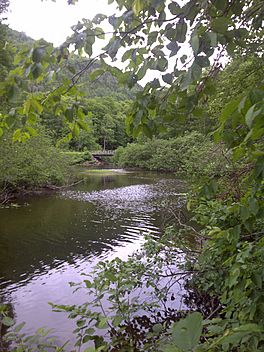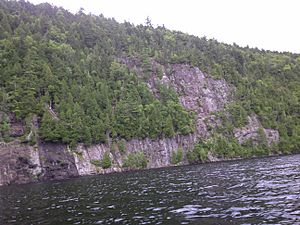Missionary Lake facts for kids
Quick facts for kids Missionary lake |
|
|---|---|

"Passe à Groleau" (Groleau Strait) separating the northern and southern parts of Missionary lake. The bridge (in background) serves cottages located on the northeast shore, in the middle of the "Missionary lake".
|
|
| Lua error in Module:Location_map at line 420: attempt to index field 'wikibase' (a nil value). | |
| Location | Quebec, Canada |
| Type | natural |
| Primary inflows | surrounding streams |
| Primary outflows | Discharge toward Mékinac Lake |
| Basin countries | Quebec, Canada |
| Max. length | 13 km (8.1 mi) |
| Max. width | 1.2 km (1 mi) |
| Surface area | 5.93 km2 (2.29 sq mi) |
| Max. depth | 61 m (200 ft) |
| Surface elevation | 167 m (548 ft) |
| Settlements | Trois-Rives, Lac-aux-Sables |
Missionary Lake is a beautiful lake located in the province of Quebec, Canada. It stretches across two towns, Trois-Rives and Lac-aux-Sables. The lake was once called "Grand Long Lake." It got its current name to honor Paul Le Jeune, a missionary and explorer. He helped start a Jesuit mission in 1634 in nearby Trois-Rivières, Quebec.
Contents
A Look Back in Time
Old Travel Routes
Long ago, the Mékinac River and Missionary Lake were important travel paths. They connected the Saint-Maurice River and Batiscan River. In winter, these routes were also used by loggers. They used horse-drawn sleighs to reach logging areas around Missionary Lake.
Changes in Transportation
The need for these paths changed when a railway was built in 1908. This railway connected Hervey-Jonction to La Tuque. Today, the Mekinac/Missionary route is used for fun. People ride snowmobiles and ATVs on it from early December to late March.
The Groleau Sawmill
In 1938, a company called Groleau built a sawmill at the south end of Missionary Lake. It was about 4.3 kilometers from Hervey-Jonction. Sadly, a fire destroyed the mill on June 27, 1955. It was then rebuilt in the village of Sainte-Thècle.
Today's Economy
Today, the area around Missionary Lake focuses on tourism and forestry. It's a great place for many outdoor activities. You can go hunting, fishing, and camping. People also enjoy water sports, watching nature, and picking wild fruits.
Exploring Missionary Lake
Two Parts of the Lake
Missionary Lake is split into two main parts: a northern part and a southern part. These two parts are connected by a narrow passage called Groleau Strait. This strait is about 0.77 kilometers long. Water flows from the southern part of the lake into the northern part through this strait.
Small boats can enter the strait from the southern side. There's a wider section in the middle of the strait, about 0.5 kilometers long. However, the strait can be tricky to navigate. It's narrow and shallow in some places, with rocks at the bottom. If you're using a canoe, you might need to carry it (portage) to get into the northern part of the strait. A bridge crosses the strait at its northern end. This bridge helps people get to cottages on the northeast shore of the lake.
The Southern Lake Section
The southern part of Missionary Lake is located in both Lac-aux-Sables and Trois-Rives. This section of the lake is long and narrow, stretching from north to south. It is about 5.1 kilometers long and up to 0.5 kilometers wide. You can reach the southern part of the lake by road from the Hervey-Jonction area. The road is called Missionary Lake Road and runs along the southwestern side of the lake.
The Northern Lake Section
The northern part of Missionary Lake is also long and narrow, running north to south. It measures about 7.1 kilometers in length and 1.2 kilometers wide. The water from this northern part flows out from its northwest end. It travels about 3.18 kilometers to Mékinac Lake, passing through smaller lakes like Lac à la Puce. This water eventually joins Mékinac Lake near its dam.
You can get to the northern part of Missionary Lake by road from the village of Saint-Joseph-de-Mékinac. You take Lake Mékinac Road for 8.5 kilometers, then turn onto Missionary Lake Road for another 4.2 kilometers.
Why the Name "Missionary Lake"?
The name "Missionary Lake" was chosen to honor Paul Le Jeune. He was a Jesuit missionary who came from France. He helped found the mission in Trois-Rivières in 1634 and Ville-Marie (which is now Montreal) in 1642. Paul Le Jeune was a famous explorer of New France.
In the area around Sainte-Thècle, several places are named after him. These include Canton Lejeune, Lac Lejeune, and Lake Jesuit. In Saint-Tite, the Paul Le Jeune High School, which opened in 1969, also honors him. The name "Missionary Lake" was officially recorded on December 5, 1968.


